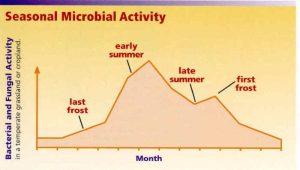Summer heat is on the way. Environmental (abiotic) stressors–especially drought and heat–can put your turf to the test. When talking about summer fertility for turf grass, we want to focus on the importance of potassium. Potassium is a primary macronutrient in the turf plant. As such, potassium is required in large quantities annually, and for good reason. This macronutrient is essential in the metabolic processes (mobilization of nutrients in the turf plant) and it’s primarily responsible for turgor pressure in the plant.
So, what does that all mean? In short: potassium is vital to the turf plant’s health and resilience.
Plant Metabolism
Yes, this may seem obvious. Similar to calcium, potassium helps move nutrients in and throughout the turf plant. The mobilization of nutrients–most notably iron, which is fundamental in photosynthesis and chlorophyll synthesis—is dependent on potassium availability in the soil.
Potassium deficiency most often presents as browning or yellowing turf plants. This is due to a lack of carbon (glucose) creation as a byproduct of photosynthesis. In an Organic Turf Care Program, our goal is to create the most self-sustaining turf stand possible. Self-sustaining turf cannot be achieved without giving the plants the ability to produce energy on their own. For turf plants to perform well in stressful environments, we have to supply them with potassium so it can best regulate its biochemical and hormonal relationships.
Turgor Pressure
Turgor pressure describes the plant cells’ ability to hold water or to remain ‘turgid’. Natural turf lawns and athletic fields are under stress for a multitude of reasons. When grass is being walked about or played on, its ability to bounce back or stand back upright is directly correlated to its turgor pressure.
When potassium is present in the turf plant it helps facilitate water movement into cells via semipermeable membranes and out of cells via stomata. This is especially critical in times of drought when we want the turf plant to keep water ‘in’. Think of stomata as doors for water movement out of the cell and potassium as gatekeepers. During summer and winter environmental stress, we want plenty of gatekeepers keeping those doors closed and water in the turf plant. When water moves out of the cells through the stomata, the turf plant wilts. Accordingly, this wilting leads to quicker dormancy and higher susceptibility to disease and wear.
The best ways to deliver potassium during the early summer application window is using PJC ProHealthy Turf 8-0-6 and 6-0-6. Deliver a combination of nitrogen and potassium to keep your lawns and athletic fields as strong as possible during the summer.
Soil Biology
As it pertains to soil biology, let’s look at the “Seasonal Microbial Activity” graph for reference.

Unsurprisingly, biological activity in the soil mirrors productivity of the turf grass seasonally. The soil microbes are most active between May and the end of June – our peak growing season in the Northeast. Accordingly, we target the use of Charge-S3 as a bio-stimulant in our programs during this application window. Keeping the microbes fed and happy during peak growing season is fundamental in organic programs. This involves providing a combination of molasses, bone meal, kelp and soybean meal for a stable and easily digestible food source. This is vital as they in turn provide essential nutrients to the turf in their bioavailable form. Added biochar improves organic matter composition, which increases nutrient and water holding capacity in the soil right before peak environmental stress of summer heat and drought. The “first frost” spike generally in early fall signals microbe reproduction before they begin to go dormant over the winter (which is also a critical feeding window for soil biology).
The two parts of PJC’s Healthy Turf Circle – Soil Chemistry and Soil Biology – are especially critical going into summer and can easily be addressed through use of our Proven Products. When you dig into summer fertility for turf grass, be sure to also address cultural practices. Combine mowing high and watering deeply and infrequently, to set yourself up for success in the summer heat.
